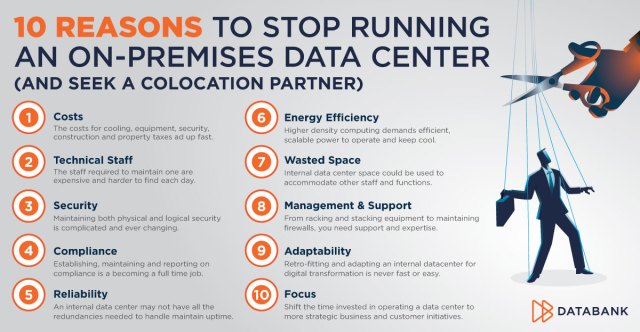
At the Data Center Crossroads: On-Premise, or Partner?
At some point, many businesses will confront the strategic decision of whether to operate an on-premises data center or collocate in an outsourced one. Operating your facility can be quite an undertaking – requiring expertise in power and environmental controls and responsibility for ongoing maintenance of information technology assets, from hardware to security. Deciding whether to build and operate an internal data center or turn to an outside partner, is a major strategic technology decision.
As the saying goes, most businesses aren’t in the data center business, which begs the question: should you be allocating time and resources to an internal data center? It makes sense for some organizations, while others would do well to consider alternative options.
Whichever path you choose, evaluating some of the decision factors for opting out of the internal data center enterprise is a good place to start. Below, we’ve outlined ten reasons to stop running an on-site data center.
1. Costs
Cost analysis is often the first exercise your business must walkthrough in the quest to determine whether maintaining or building an internal data center makes good business sense. Investing in a private facility can seem like an attractive option for organizations who feel strongly about keeping their IT assets close to their physical location, have very specific security and compliance requirements or simply prefer to keep technology management in-house.
However, depending on your needs, the costs of running an internal data center can be impractical when you factor in heating, cooling, power, equipment, etc. If you’re set on running an internal data center, expect to foot the bill for the following:
For many businesses, it’s simply not economically feasible to build or continue to run an internal data center. Opting for colocation, cloud or hybrid environment offsets these costs significantly. Paying for colocation monthly reduces capital expenses significantly, simplifies the challenge of future expansion, and eliminates the many economic pressures of dealing with your own data center.
2. Staffing and technical skillsets
While the skill set required to build a data center is significant, the technical acumen required to maintain and operate one can be just substantial, crossing multiple IT practice areas and requiring a great deal of expensive and difficult to find engineering talent.
And to make matters worse, the data center industry is facing a staffing crisis. Most organizations report experiencing significant difficulty in recruiting and retaining staff.
61% of businesses have trouble retaining or recruiting data center staff – a 6% increase from 2018 (Uptime Institute).
Opting to partner with a data center vendor who can offer a diverse range of options for your IT environment allows you to eliminate the stress of hiring and training staff. It can be easier to rely on specialized engineering and facilities staff to monitor your IT assets for you.
3. Security
Security is perhaps one of the greatest pressures of the internal data center, both physical and logical.
From a physical security perspective, there are countless tactics that can be utilized and combined to form a physical security strategy for your facility. This is often where security meets with compliance. Depending on your industry, customer base, and the nature of the data you deal with, the compliance requirements you’re subject to may stipulate physical security requirements for your data center. Here are just a handful of physical security measures many companies choose to employ:
Then, of course, there’s logical security, which breaks down into numerous practice areas from network to information security. A common, and often overlooked, security risk found in on-premises data centers is technical debt. Older operating systems and legacy apps often have vulnerabilities that can introduce serious risks to data centers (Data Center Knowledge) and ineffective changelogs in older systems can make it significantly more difficult to detect attackers.
Leaning on a reliable partner, whether for colocation space, cloud or a mix, often reduces risk. Be aware that some data center vendors take more responsibility for more controls than others. If you choose to evaluate outside support, be certain your security personnel conducts an adequate evaluation to understand what sorts of controls, both physical and logical, are included or can be purchased as a service.
Also be aware that regardless of a provider’s security offerings, your business is responsible for your own data 100% of the time—this is a frequent misunderstanding among data center customers.
4. Compliance
Most organizations are subject to some sort of compliance regulations, be it HIPAA, PCI, or FedRAMP. Compliance isn’t known for being a simple practice area. The list of regulatory bodies and requirements is long and winding. Parsing out what you’re subject to, and how to establish and maintain compliance simply based on the data you deal with, is an undertaking on its own. That doesn’t include the many requirements which come along with an on-premises data center. It requires professional expertise, and not all businesses have the luxury of an on-staff CISO or compliance officer.
Plus, we all know by now, the consequences of noncompliance are steep. Take your pick in terms of major incidents: consider the Anthem breach that happened several years ago—the health insurance corporation was fined $16 million by the U.S. government for failure to comply with HIPAA (HealthLeaders Media).
The good news is this: compliance is part and parcel to several data center partner services. No one can assume responsibility for compliance on behalf of your business, but many data center providers can offer consulting services, share advice, or at the very least have on-staff compliance experts. They’re also required to maintain data center compliance with regulations such as SSAE 18. Keep in mind that hyper-scale public clouds are less likely to offer support for complex compliance requirements.
5. Reliability
Disruption and disaster events run the gambit, whether we’re talking about a technician stepping on a cable and mistakenly unplugging it or a massive hurricane that strikes your data center facility.
In 2019, 34% of businesses suffered some form of an outage of service disruption, many of which came with considerable financial ramifications. 50% have experienced an outage or disruption in the past three years.
10% of companies say their most recent significant outage exceeded $1 million.
Power loss accounted for one-third of outages while networking issues caused 31% (Uptime Institute).
Reliability brings different levels of concern for different companies. There are many factors to consider, from geographic location to infrastructure. Using a qualified data center partner reduces the need to worry about these issues. A Tier III data center will have been engineered from the ground up for inherent reliability, with redundant environmental systems, diverse power and network sources, and a location chosen for its reduced exposure to natural or man-made disasters.

6. Energy efficiency
The factor of power efficiency will vary from business to business. A data closet has very different needs from a full-on data center facility. Whether you’re buying fans to cool off your server room or your environment calls for overhead power and cooling systems, power efficiency and cost can become an issue.
Modern HVAC technologies and systems are highly complex and require skill sets to effectively manage. The more sophisticated your physical environment is, the more equipment and expertise you’ll need.
Today, most companies are aiming to consolidate their environments while maintaining tight SLAs and reasonable costs. Delivering on these objectives in terms of power is no easy feat when you’re building and operating your own data center.
High-quality data center facilities make the power and cooling part of the package in a fashion that will fit within your IT budget. Many providers are integrating innovative, high-efficiency technologies to offer customers further cost savings.
7. Wasted space
As your business grows, so does your data center. Depending on the nature and volume of your business, the physical space a data center can occupy can become extensive and burdensome. In some cases, your real estate is better used to accommodate new staff or maintain the most critical components of your infrastructure, while less vital assets can be offloaded to a colocation facility. Utilizing an off-site data center provides tremendous flexibility, allowing you to selective add space as needed, without overextending an expensive lease.
8. Access to managed services and remote hands
This relates closely to the staffing and skillsets challenges of internal data centers. With data centers, come IT assets, and with IT assets come many responsibilities; from racking and stacking equipment to maintaining firewalls. You need expertise to properly care and feed your data center, and the more it grows, the more staff you’ll require.
If you go the colocation, cloud or hybrid cloud route, a well-rounded service provider will usually offer managed services, taking care and feeding off the table for your business. Increasingly, OEMs and data center providers recognize the need to offer complete solution suites rather than single IT infrastructure components. Look for the following services if you’re thinking of cutting ties with your data center:
Be mindful of your search. Some IT service providers are billed as MSPs but are very limited in their offerings. You’re better off selecting a partner who can create a full, customized solution set. And remember, managed services can be particularly helpful if you are pursuing a hybrid IT strategy.
9. Be ready for change
Technology moves fast. We’re all aware of the digital transformation discussion, regardless of your respective industry. It’s been said many times that every company is a technology company, and the concept is hard to argue with. Businesses of all sizes and backgrounds must be quick, agile, and ready to compete, and sound technology and digital transformation strategy are the foundation for these objectives.
It’s easier to be quick on your feet when you let experts handle your IT. Few things are more distracting from innovating and competing in the market than daily IT operations. If you don’t have an extensive internal IT department to maintain your data center, it could be argued that your ability to be agile is hampered.
10. Better for business
What is your business, exactly? We’re going to venture to guess that it’s not running a data center. And if it’s not, why are you investing the time and resources to run your own data center? What could you do with all the extra time you’d gain if you offloaded the obligations and refocused your efforts and capital on the functions that are core to your business and the happiness of your customers?
Like we mentioned in the beginning, there are some organizations for which building and/or running an on-premises data center makes good business sense. But for many, it doesn’t. We encourage you to take a closer look at your technology strategy and gain insights into what is most advantageous for your business, end-users, and customers.


Discover the DataBank Difference today:
Hybrid infrastructure solutions with boundless edge reach and a human touch.